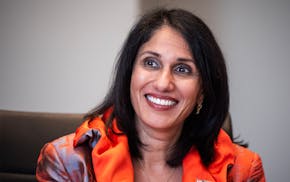The Minnesota Paradox — the wealth gap between white and nonwhite residents in spite of the state's exceptional prosperity — could evaporate over the next few decades without much change by businesses, nonprofits and government.
It would be much better, however, if Minnesotans stopped muddling along on matters of race and money — and made some difficult changes.
Minnesota is one of the nation's slower-growing states and, since the early 2010s, all of our population growth has come from people of color. The state's record of economic success will diminish if its residents of color don't become far more wealthy.
Fixing the paradox is difficult because it's a product of culture, said Samuel Myers, the University of Minnesota economist who coined the Minnesota Paradox in an essay several years ago. Institutions have formed around it, thinking has been hardened by it. "How people institutionalize things doesn't always reverse itself," he told me earlier this year.
Indeed, the paradox illustrates how Minnesotans struggle to balance individual rights with the common good, the essential tension in all democracies.
People are motivated by economic incentives and penalties, though. My goal with this series was to get beyond the tropes permeating discussions on race in recent years and find where incentives and penalties distorted to allow the Minnesota Paradox persist.
Today, let's revisit the distortions in the order I wrote about them, with some ideas about where I think we're going. Write me with your ideas and I'll explore them in future columns.
Segregated schools
The pandemic damaged attendance and student performance statewide. Even before it, an innovation meant to reduce the gap in educational performance by race — charter schools — had in the Twin Cities made them worse.
Two weeks ago, the Minnesota Star Tribune produced a deeply reported set of stories about the poor academic results of charter schools. The state pioneered charter schools in the early 1990s, and in 1998 became the only one to exempt them from complying with the integration requirements of public schools.
That allowed charters to narrow their focus and appeal along racial lines. Today, around 80% of the state's 200 or so charters are dominated by students from a single race. Charter schools play a useful role in the education ecosystem. They shouldn't have become places for families to hide from society's complexity and diversity, however.
For more than a quarter-century, no state official opposed this re-emergence of segregation, nor the damage it did to both charters and traditional schools, nor the decline in academic outcomes it helped spawn. A former teacher smartly observed in the Star Tribune's op-ed pages last week that "Minnesota's entire public education system needs a bold, shared reimagining."
Instead, it's all been punted to the courts. Watch for action a few years from now in a lawsuit known as Cruz-Guzman, which accuses the Minneapolis and St. Paul public school districts of violating the state constitution's education clause with segregated schools. Charter schools joined on the side of the districts, aiming to preserve their business as racial silos.
A trial is set for 2026, and appeals could take until 2029 or 2030. But we've had signs of the likely outcome.
Minnesota Supreme Court Chief Justice Natalie Hudson, in an opinion on a procedural matter in the case last December, wrote, "For far too long, communities of color have watched their children languish in the traditional public school system, while their cries for reform fell largely on deaf ears. These communities have grown tired and impatient. The development of charter schools is thus an understandable response."
Having teed up the ball, she then knocked the cover off it.
"Although the charter schools tout their own successes, they do not grapple with the indisputable de facto segregation and racialized disparities in academic outcomes happening outside of their schoolhouse walls," Hudson wrote.
In a footnote, she added the achievements of the charters intervening in Cruz-Guzman "may be outliers among charter schools with a high concentration of students of color."
Minnesota's economy, ever more reliant on its residents of color, will take a gut punch if we have to wait four or five years for Hudson and the other Supreme Court justices to end segregation in schools.
Available and accessible housing
The shortage of housing for lower-income families, which has lasted decades in Minnesota, went upmarket over the last 15 years or so. Today, middle-income earners are finding it harder to buy a home, even in some of the state's smaller communities.
That ought to get city councils, planners and other housing authorities off the dime and onto allowing more types of homes in more places. Fifty years ago, the Metropolitan Council used its control of infrastructure funding to force suburbs to accommodate more multifamily and affordable housing. It needs to flex that muscle more today.
The council and the state housing agency, Minnesota Housing, in the 1980s and 1990s bowed to leaders in Minneapolis and St. Paul who wanted more affordable housing inside city limits. Today, it's clear that effort has gone on too long and the council and state agency are under pressure in courts and the Legislature to jump-start affordable development in the suburbs.
This spring, state lawmakers didn't act on legislation that would have ended zoning for single-family homes in towns larger than 10,000 people. But the issue is bound to come up again next year, after also showing up in the presidential campaign.
Even exurban areas need to rethink housing restrictions. For instance, in parts of Wright County, people who own 40 acres can't build more than one house. That limit will be tested as the metro area population extends northwestward in coming years.
Building social capital
Minnesotans should get out of their boxes, which are both literal and figurative. I saw a heartening example in Osseo earlier this month, when I met Denishia Moore, the only woman of color in the local Lions club, and the people who invited her to join it.
The leveling off of population growth is a new phenomenon, and it means everyone in the state needs to reconsider their expectations and assumptions about who belongs in what job, or what club or what place.
When I mentioned to a progressive activist earlier this year how I believe Minnesota will be leaning on its residents of color for economic success more than ever before, he responded that Minnesota and America have always relied on people of color for economic gain — by taking advantage of them.
He was thinking in his realm of expertise. I wasn't talking about cheap labor, though. I meant all labor and, beyond that, leadership.
On the other hand, after the first column in this series published, some readers said it's unfair to give special privileges, such as lower-cost business loans or scholarships, to people of color. "The only way to reduce disparities and racism is to advocate treating Whites and Blacks equally," one wrote to me.
I think it is too much to expect that decades of unfairness will be remedied by actions that are perfectly fair.
Besides, even if someone is given a break, no one is promised success. When opportunities emerge, we compete.
This is last in an occasional series on breaking Minnesota's patterns on race and money.

Ramstad: Minneapolis' Camden neighborhood is rising. Houston White wants to keep it that way.

Ramstad: Minnesota's big businesses are in crisis with a common problem

Ramstad: No business can 'eat' all the tariffs, not even Walmart

Ramstad: Donaldson is protected from tariff chaos after expanding globally the right way


